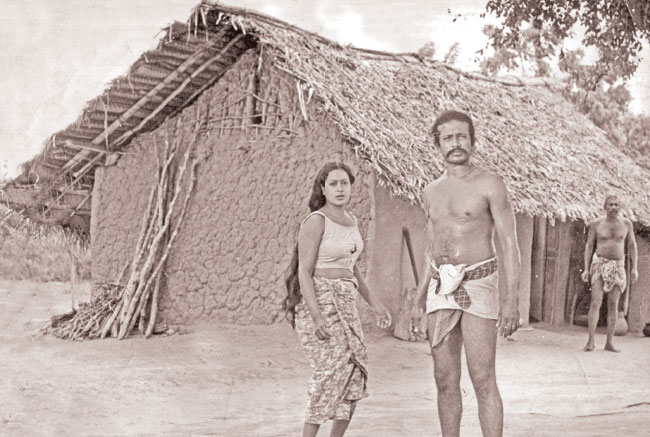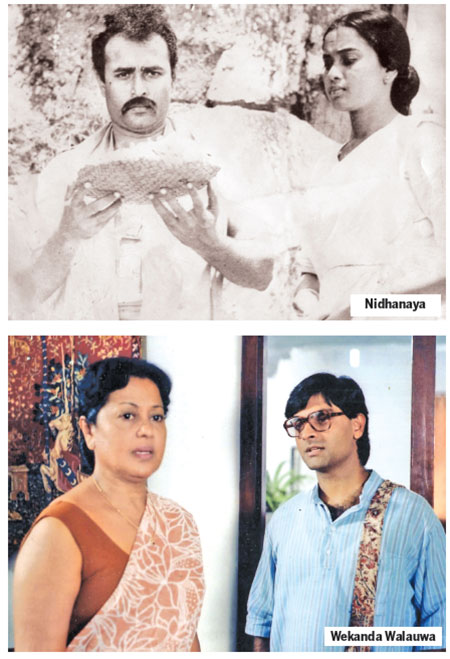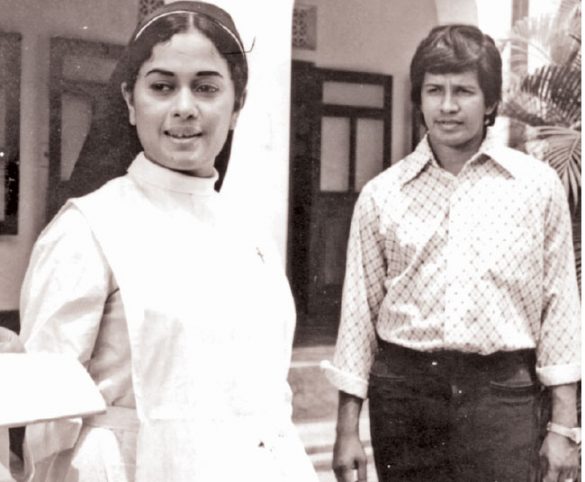The year was 1977, the venue The International Film Festival in Delhi, India. Sri Lanka’s entry in the competition was Amaranath Jayathilake’s Siripala and Ranmenika. Playing the title role of the outlaw’s wife was Malini Fonseka, looking every inch the glamorous film star. The scene now shifts to the grand dining hall of the Ashok Hotel, where official guests and the members of the Jury were lodged. Chairman of the Jury was the great Indian director Satyajit Ray. Seated alone in splendid isolation with that combination of grandeur, awe, and elegance—rather like an Indian prince—was Ray, nibbling at his lunch, a far-away, distracted look on his face. Seeing me enter the hall, he called me over to the table, as it turned out to be, to divulge a jury secret. That morning they had seen the Sri Lankan film. He had been enormously impressed by Malini’s performance.

Beddegama
“Keep this to yourself,” he said, stretching his 6 ft 5 in frame over the table. “I must get this girl an award, some award – It’s unfortunate the film’s been scheduled so late. The jury has decided on the Best Actress award and it’s too late to upset the jury’s verdict. At least I’ll get her a Special Diploma. What surprises me is the actress I’ve seen around here and the character on the screen is one and the same person. I can tell you this. No Bengali actress, however good she may be, will ever allow herself to be so distorted as Malini is in the Sri Lankan film – no, not even in a film of mine.”
What Ray found difficult to reconcile were the two images—one, the glamorous film star physically present at the festival and the disfigured face of Ranmenika in the film.
As Sumithra and I had to leave the festival before it ended, I thought I should at least confide in Malini that she might win something, though I tried to be as vague as possible. It was a bitter-sweet triumph in that there was apparently no time to have the Special Diploma of Honour ready at the award-winning ceremony which brings the curtain down at the end of the Festival. Malini had to be content with a special reception at the Indian High Commission in Colombo a few weeks later.

However, to have made such an impact on one of the world’s greatest directors—particularly one who has excelled in moulding great performances from actresses in his native Bengal, viz. Madhabi Mukherjee, Sharmila Tagore, Mamta Shankar, Karuna Banerjee etc.—I should think is reward enough.
Malini has acted in five major films of mine. In three of them—Nidhanaya, Baddegama and WekandaWalauwa—she created three unforgettable characters: the virginal, sacrificial victim in Nidhanaya, the young village lass who turns into an old hag waiting for death in Woolf’s classic Baddegama, and the aging widow, her private grief etched on her wrinkled face as gradually she loses her son, her husband, her mansion, her dignity in the longest performance of her career.
Cast for her skill in portraying diverse characters, driven to the brink by private tragedies, she has never failed—at least in the estimation either of the director or the critics, both local and foreign. I have never cast her because of her popularity, but almost as a challenge to her popular image in the numerous commercial films in which she has been acting. To play the old hag, to look plain, unattractive, if the character demanded it, was never a problem for her. In terms of sheer range, from the singing, dancing heroine of the formula film to Ranmenike, Podi Menike and the remarkable characters in DharamasenaPathiraja’s films, driven by narrative complexities and social and political imperatives of a “New Cinema”, she has never faltered. It has been so with many other directors.
What is quite remarkable is also her personal popularity with the masses. Not since Rukmani Devi has an actress been so beloved of the people—and by the people.
To have acted in well over a hundred films is in itself an achievement, particularly in the context of an industry notoriously unstable—a helpless victim of conflicting government policies, regarded as commercially non-viable despite the Government’s 100% Tax Exemption Scheme for investment in films.

Hithuwoth hithuwamai
It may be pointed out by some that most of her films are commercial and therefore unworthy of serious attention, but these are the very films that the masses remember her by. Some of us tend to forget that switching over from the acting style demanded by the commercial formula film to the more serious film depends on a change of technique—of sensibility—which by its very nature is a creative process. And it is in making this transition that Malini has triumphantly succeeded.
In this brief tribute, it would be difficult to discuss her work as a director in her own right and her contribution to the small screen—both as actress and director—though mention must be made of her extraordinary performance in Tissa Abeysekera’s epic TV series Pitagamkarayo. Suffice it to say that on the occasion of a special homage to Malini Fonseka, all of us who have worked in the Sri Lankan cinema will wish her many more years in a medium that has been enriched by her outstanding talents.
(This article is a reprint of “Malini Fonseka: A Tribute” by the late Dr. Lester James Peries, originally published in 2009 in the felicitation volume Malini Jivamana Puravurthaya, edited by Dhammika Dissanayake and published by Surasa Publications to honour Malini Fonseka.)

